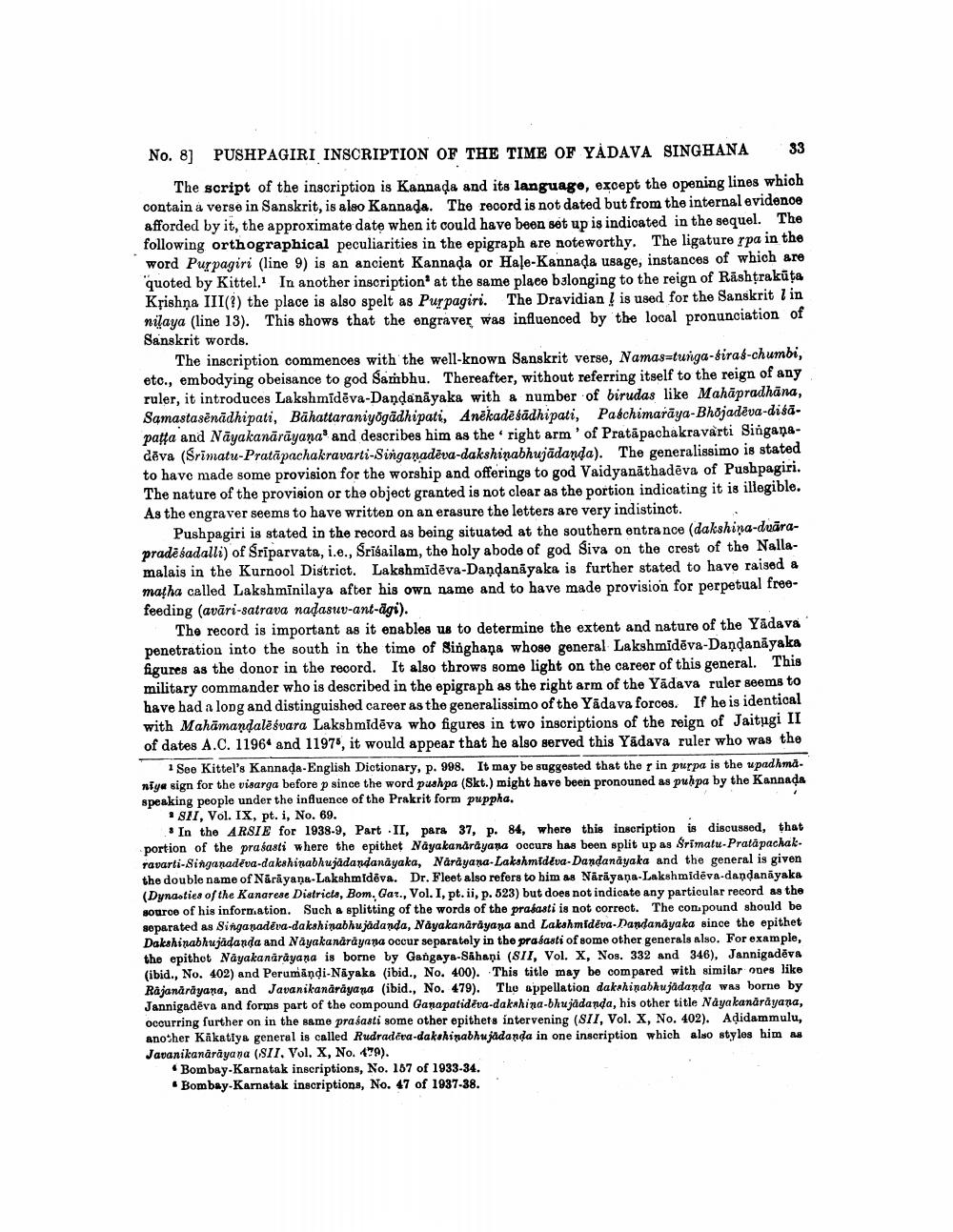________________
No. 8] PUSHPAGIRI INSCRIPTION OF THE TIME OF YÅDAVA SINGHANA 33
The script of the inscription is Kannada and its language, except the opening lines which contain a verse in Sanskrit, is also Kannada. The record is not dated but from the internal evidence afforded by it, the approximate date when it could have been set up is indicated in the sequel. The following orthographical peculiarities in the epigraph are noteworthy. The ligature rpa in the word Pur pagiri (line 9) is an ancient Kannada or Hale-Kannada usage, instances of which are quoted by Kittel. In another inscription at the same place balonging to the reign of Rashtrakūta Krishna III(1) the place is also spelt as Purpagiri. The Dravidian ! is used for the Sanskrit lin nilaya (line 13). This shows that the engraver was influenced by the local pronunciation of Sanskrit words.
The inscription commences with the well-known Sanskrit verse, Namas-tunga-tiras-chumbi, etc., embodying obeisance to god Sambhu. Thereafter, without referring itself to the reign of any ruler, it introduces Lakshmidēva-Dandanayaka with a number of birudas like Mahāpradhāna, Samastasēnādhipati, Bāhattaraniyögādhipati, Anekadēsādhipati, Paschimarāya-Bhojadēva-diśāpatta and Nāyakanārāyana and describes him as the right arm of Pratápachakravarti Singanadēva (Srimatu-Pratāpachakravarti-Singanadēva-dakshinabhujādanda). The generalissimo is stated to have made some provision for the worship and offerings to god Vaidyanāthadēva of Pushpagiri. The nature of the provision or the object granted is not clear as the portion indicating it is illegible. As the engraver seems to have written on an erasure the letters are very indistinct.
Pushpagiri is stated in the record as being situated at the southern entrance (dakshina-duārapradėśadalli) of Sriparvata, i.e., Srisailam, the holy abode of god Siva on the crest of the Nallamalais in the Kurnool District. Lakshmidēva-Dandanayaka is further stated to have raised & matha called Lakshminilaya after his own name and to have made provision for perpetual freefeeding (avāri-satrava nadasuv-ant-agi).
The record is important as it enables us to determine the extent and nature of the Yadava penetration into the south in the time of Singhana whose general Lakshmidēva-Dandanāyaka figures as the donor in the record. It also throws some light on the career of this general. This military commander who is described in the epigraph as the right arm of the Yādava ruler seems to have had a long and distinguished career as the generalissimo of the Yadava forces. If he is identical with Mahamandalēśvara Lakshmidēva who figures in two inscriptions of the reign of Jaitugi II of dates A.C. 11964 and 11975, it would appear that he also served this Yadava ruler who was the
1 See Kittel's Kannada-English Dictionary, p. 998. It may be suggested that the r in purpa is the upadhma. niye sign for the visarga before p since the word pushpa (Skt.) might have been pronouned as puhpa by the Kannada speaking people under the influence of the Prakrit form puppha.
* SII, Vol. IX, pt. i, No. 69.
* In the ARSIE for 1938-9, Part II, para 37, p. 84, where this inscription is discussed, that portion of the prasasti where the epithet Nayakanarayana occurs has been split up as Srimatu-Pratápachak. ravarti-Singaradeva-dakshinabhujadandanayaka, Narayana Lakshmidēva-Dandanayaka and the general is given the double name of Narayana Lakshmidēva. Dr. Fleet also refers to him as Narayana Lakshmidēva-dandanayaka (Dynasties of the Kanarese Districta, Bom, Gar., Vol. I, pt. ii, p. 323) but does not indicate any particular record as the source of his information. Such a splitting of the words of the prasasti is not correct. The con pound should be separated as Singanadēva-dakshinabhujādanda, Nayakanārāyana and Lakshmidēva. Dandanayaka since the epithet Dakshinabhujadanda and Nayakanarayana occur separately in the prasasti of some other generals also. For example, the epithet Nayakanarayana is borne by Gangaya-Sahaņi (8I1, Vol. X, Nos. 332 and 346), Jannigadēva (ibid., No. 402) and Perumandi.Niyaka (ibid., No. 400). This title may be compared with similar oues like Rajanārāyana, and Javanikanarayana (ibid., No. 479). The appellation dakshinabkujādanda was borne by Jannigadēva and forms part of the compound Ganapatidēva-dakahina-bhujādanda, his other title Näyakanārāyana, occurring further on in the same prasasti some other epithets intervening (SII, Vol. X, No. 402). Adidammulu, another Kakatiya general is called Rudradiva-dakshinabhu jadanda in one inscription which also stylos him as Javanikanarayana (SII, Vol. X, No. 479).
• Bombay-Karnatak inscriptions, No. 107 of 1933-34. • Bombay-Karnatak inscriptions, No. 47 of 1937-38.




